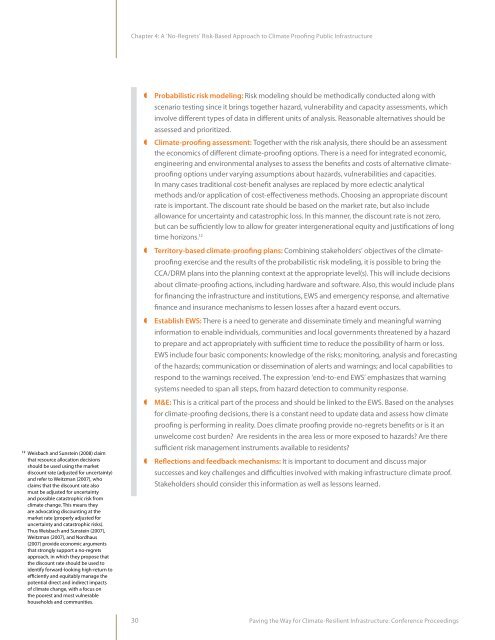Paving the Way for Climate-Resilient Infrastructure - UN CC:Learn
Paving the Way for Climate-Resilient Infrastructure - UN CC:Learn
Paving the Way for Climate-Resilient Infrastructure - UN CC:Learn
Create successful ePaper yourself
Turn your PDF publications into a flip-book with our unique Google optimized e-Paper software.
Chapter 4: A ‘No-Regrets’ Risk-Based Approach to <strong>Climate</strong> Proofing Public <strong>Infrastructure</strong>12Weisbach and Sunstein (2008) claimthat resource allocation decisionsshould be used using <strong>the</strong> marketdiscount rate (adjusted <strong>for</strong> uncertainty)and refer to Weitzman (2007), whoclaims that <strong>the</strong> discount rate alsomust be adjusted <strong>for</strong> uncertaintyand possible catastrophic risk fromclimate change. This means <strong>the</strong>yare advocating discounting at <strong>the</strong>market rate (properly adjusted <strong>for</strong>uncertainty and catastrophic risks).Thus Weisbach and Sunstein (2007),Weitzman (2007), and Nordhaus(2007) provide economic argumentsthat strongly support a no-regretsapproach, in which <strong>the</strong>y propose that<strong>the</strong> discount rate should be used toidentify <strong>for</strong>ward-looking high-return toefficiently and equitably manage <strong>the</strong>potential direct and indirect impactsof climate change, with a focus on<strong>the</strong> poorest and most vulnerablehouseholds and communities.Probabilistic risk modeling: Risk modeling should be methodically conducted along withscenario testing since it brings toge<strong>the</strong>r hazard, vulnerability and capacity assessments, whichinvolve different types of data in different units of analysis. Reasonable alternatives should beassessed and prioritized.<strong>Climate</strong>-proofing assessment: Toge<strong>the</strong>r with <strong>the</strong> risk analysis, <strong>the</strong>re should be an assessment<strong>the</strong> economics of different climate-proofing options. There is a need <strong>for</strong> integrated economic,engineering and environmental analyses to assess <strong>the</strong> benefits and costs of alternative climateproofingoptions under varying assumptions about hazards, vulnerabilities and capacities.In many cases traditional cost-benefit analyses are replaced by more eclectic analyticalmethods and/or application of cost-effectiveness methods. Choosing an appropriate discountrate is important. The discount rate should be based on <strong>the</strong> market rate, but also includeallowance <strong>for</strong> uncertainty and catastrophic loss. In this manner, <strong>the</strong> discount rate is not zero,but can be sufficiently low to allow <strong>for</strong> greater intergenerational equity and justifications of longtime horizons. 12Territory-based climate-proofing plans: Combining stakeholders’ objectives of <strong>the</strong> climateproofingexercise and <strong>the</strong> results of <strong>the</strong> probabilistic risk modeling, it is possible to bring <strong>the</strong><strong>CC</strong>A/DRM plans into <strong>the</strong> planning context at <strong>the</strong> appropriate level(s). This will include decisionsabout climate-proofing actions, including hardware and software. Also, this would include plans<strong>for</strong> financing <strong>the</strong> infrastructure and institutions, EWS and emergency response, and alternativefinance and insurance mechanisms to lessen losses after a hazard event occurs.Establish EWS: There is a need to generate and disseminate timely and meaningful warningin<strong>for</strong>mation to enable individuals, communities and local governments threatened by a hazardto prepare and act appropriately with sufficient time to reduce <strong>the</strong> possibility of harm or loss.EWS include four basic components: knowledge of <strong>the</strong> risks; monitoring, analysis and <strong>for</strong>ecastingof <strong>the</strong> hazards; communication or dissemination of alerts and warnings; and local capabilities torespond to <strong>the</strong> warnings received. The expression ‘end-to-end EWS’ emphasizes that warningsystems needed to span all steps, from hazard detection to community response.M&E: This is a critical part of <strong>the</strong> process and should be linked to <strong>the</strong> EWS. Based on <strong>the</strong> analyses<strong>for</strong> climate-proofing decisions, <strong>the</strong>re is a constant need to update data and assess how climateproofing is per<strong>for</strong>ming in reality. Does climate proofing provide no-regrets benefits or is it anunwelcome cost burden? Are residents in <strong>the</strong> area less or more exposed to hazards? Are <strong>the</strong>resufficient risk management instruments available to residents?Reflections and feedback mechanisms: It is important to document and discuss majorsuccesses and key challenges and difficulties involved with making infrastructure climate proof.Stakeholders should consider this in<strong>for</strong>mation as well as lessons learned.30<strong>Paving</strong> <strong>the</strong> <strong>Way</strong> <strong>for</strong> <strong>Climate</strong>-<strong>Resilient</strong> <strong>Infrastructure</strong>: Conference Proceedings
















